- April 4, 2024
Staying the course

MPC is expected to maintain the repo rate at 6.5%, cautioning amid strong GDP growth and inflation concerns.
The Monetary Policy Committee (MPC) of India is widely expected to keep the repo rate unchanged at 6.5% and maintain its “withdrawal of accommodation” stance at its April 3-5 meeting. The tone of the statement is expected to be cautious amid a still strong gross domestic product (GDP) growth — the MPC is expected to revise its FY24 GDP growth forecast up towards 8% (versus the government’s forecast of 7.6%) — and inflation risks (even as FY25 consumer price index [CPI] forecast is revised marginally lower to 4.5% amid recent cuts in retail fuel and cooking gas prices). We elaborate on the factors which, in our view, are likely to drive the monetary policy decision this week and for the rest of the year.
Likely GDP growth of 7%-plus for the fourth year in succession (Standard Chartered’s [SC’s] forecast for FY25, the year starting April 2024) reduces the need to pursue easy monetary policy in the near term. It can be acknowledged that household consumption, which accounts for 56-58% of GDP, has stayed weak; it grew by just 3% in FY24, even as aggregate GDP grew at 7.6%. More importantly, the pace of household consumption growth in FY24 is less than half of the pre-pandemic average of 7.2% during FY15-FY19.
However, a reversal can be expected in FY25, assuming a normal monsoon. SC’s data analysis indicates that inadequate monsoon rains likely weigh on household consumption demand, especially in rural areas, driven by reduced spending on food and beverages (F&B). Rural India derives c.37% of earnings from the sale of agricultural produce and in FY15-FY16, the adverse monsoon lowered household spend on F&B to an average of 1.4%, from 5.3% in FY13-FY19. This shaved 90 basis points (bps) from overall GDP in FY15-FY16 (although higher spending on other products supported household consumption). Once the impact reversed with the resumption of a normal monsoon, household demand and F&B spend picked up in subsequent years. It is believable that after an inadequate monsoon in FY24 and with an increased possibility of a normal monsoon in FY25, consumption demand is likely to see a revival, similar to the pattern seen after FY15-FY16. Thus, immediate and deep rate cuts are not needed to support growth.
Additionally, the Reserve Bank of India (RBI) has rolled out a slew of macro-prudential measures to reduce the flow of credit to unproductive sectors and to ensure medium-term financial sector stability. Any indications of rate cuts in the near term could reduce the efficacy of these policies as expectations of cheaper money can run counter to the objective of constraining credit growth to unproductive sectors of the economy.
More importantly, inflation is likely to remain a concern for the MPC, which is mandated to keep CPI at 4% on a sustainable basis within a +/-2% band. While headline CPI inflation eased to c.5% in January-February from an average 5.6% in November-December 2023, the pace of easing has been slower than expected. Elevated food prices have kept headline inflation at c.5%, despite the recent cuts in cooking gas and retail fuel prices and lower core inflation (less than 4% for three consecutive months). The March CPI inflation is expected to be at 5.05%, with core inflation likely edging up to 3.47% (from 3.34%) on higher gold prices. While a favourable base effect is likely to pull headline CPI inflation below 5% from June-July 2024, elevated food prices remain a risk, especially amid forecasts of higher-than-normal temperatures across the country. Thus, any indication of rate cuts soon seems unlikely, especially amid the crude oil price rally to $90/barrel.
Therefore, the MPC is expected to strike a cautious tone to anchor expectations on (i) the timing and (ii) the quantum of rate cuts when the easing cycle begins. While a statement around vigilance over still high inflation is likely to anchor expectations of no rate cuts before the third quarter of 2024, reiteration of the 4% medium-term inflation target, in our view, is likely to anchor expectations around the quantum of rate cuts.
FY25 CPI inflation is expected to be at 4.5%. Since a few MPC members have flagged a preference for real rates of c.1% (the repo rate less forecast headline CPI four quarters ahead), many in the market expect a deep rate-cutting cycle. However, the MPC is likely to deliver a shallow rate-cutting cycle of 50 bps (the repo rate is currently at 6.5%) as it is expected to remain cognisant of the medium-term equilibrium inflation level. It can be assumed that headline CPI will not fall below 5% on a sustained basis, as weather-related disruptions have become frequent and we see a turnaround in core CPI towards 5% by end of FY25, on improved household demand.
Overall, in a highly uncertain world, the MPC — similar to past meetings — is expected to remain cautious and reiterate data dependency for its future actions.
Anubhuti Sahay, Head of South Asia Economics Research (India) at Standard Chartered Bank penned this piece for Financial Express.
Views are personal and do not represent the stand of this publication.
